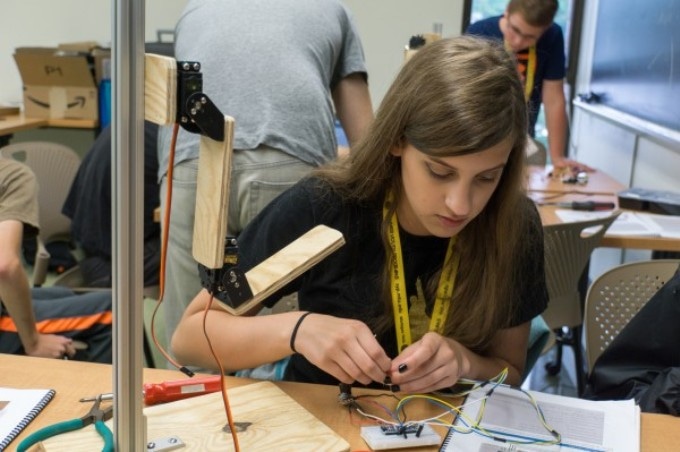Jul 20 2017
Some middle schoolers spend their summers lounging poolside or visiting grandma. Others spend part of vacation building robots.
 Kate Megnuson, who will be a high school freshman this fall in Wausau, Wisconsin, works to assemble the Neu-pulator robotic arm that reads cues from muscle sensors attached to a human arm during the co-ed version of the camp—Robotics 101—last week. (Credit: Nathan Miller)
Kate Megnuson, who will be a high school freshman this fall in Wausau, Wisconsin, works to assemble the Neu-pulator robotic arm that reads cues from muscle sensors attached to a human arm during the co-ed version of the camp—Robotics 101—last week. (Credit: Nathan Miller)
During the Women in Robotics Summer Youth Program at Michigan Technological University this week, 23 girls going into sixth, seventh, eighth or ninth grades will learn to program, wire, troubleshoot and construct two robots, the GUPPIE and the Neu-pulator.
The purpose of the camp is to teach participants how robots can assist humans in exploring the environment and can otherwise benefit us and improve quality of life.
“These concepts are to motivate students,” says Nina Mahmoudian, associate professor in the mechanical engineering-engineering mechanics department and director of the Nonlinear and Autonomous Systems Lab. “We want them to see robotics as something useful in their lives. They learn there is a lot to be done in the future. We want to ignite their curiosity, what they can do in the future. We can motivate them, engage them and they can go on and stay engaged.”
The camp, which is a collaborative effort with Mo Rastgaar, an associate professor in the mechanical engineering-engineering mechanics department and director of Human-Interactive Robotics Lab, is funded in part by grants from the National Science Foundation (NSF), which allows girls who applied to attend the competitive program at a reduced rate.
Invent with Open-Source Software
The girls will begin the week learning how to program an Arduino open-source board, how to model different parts with Autodesk Inventor software, and to understand the engineering process to solve problems. Students practice these skills in the first two days of the camp by completing small projects.
But the approach to learning isn’t the typical classroom environment.
“Everything that we do is learn and play so students internalize what they learn,” Mahmoudian says. “They take the games seriously because they are implementing their concepts. At the end, they put all the components together and make it work to play.”
The final three days of the camp are devoted to building the GUPPIEs and Neu-pulators, then testing the robots. Friday will be about swimming with the GUPPIEs and playing games using the Neu-pulators.
All sorts of problems are likely to crop up: Does the GUPPIE leak? Is the water quality sensor working? Is my arm too sweaty for the muscle sensors to read my movements and make my Neu-pulator arm do the same thing? Did I place the muscle sensor in the right place to record that muscle activity?
“These are real concepts with real engineering challenges,” Mahmoudian says. “Students are not afraid of challenges. They become seriously excited and motivated by overcoming a challenge.”
Girls in STEM
During the Robotics 101 camp last week, five girls participated in an overwhelmingly male-dominated course. They described bonding together to overcome the challenges all students faced, male or female.
“You feel a little outnumbered, but there’s pressure to keep up with the group. I still feel empowered to work by myself, even if it’s male-dominated,” says Kate Magnuson, who is going into ninth grade at D.C. Everest Junior High in Wausau, Wisconsin, and says she wants to be a computer engineer. “I want to push further in the career because I like it despite the status quo.”
Magnuson said that the sensors she worked with for the Neu-pulator were touchy, and she and her partner had to figure out how to adapt the sensors so they would work. In other words, a real-world engineering problem.
“I really liked being able to apply my knowledge of computer science to hardware and circuitry of robotics and troubleshoot problems and see how it fits together.”
And it’s the process that Mahmoudian is most intent on helping students learn and enjoy.
“The last day of camp is play time. It comes full circle for them,” Mahmoudian says. “They see their robots in action; it’s the most rewarding day for the kids. They really experience engineering challenges. If they like it, they are hooked for life.
“It’s not about the robot, not about the modeling, not about the programming. It’s about bringing computer science, mechanical engineering, industrial engineering together to make a machine that works and the students realize that,” Mahmoudian says. “We’ve given them a taste of the engineering process - brainstorm, come up with ideas, make something, troubleshoot, test and do it again. The engineering cycle is something we want to internalize in our kids regardless of the job they have.”